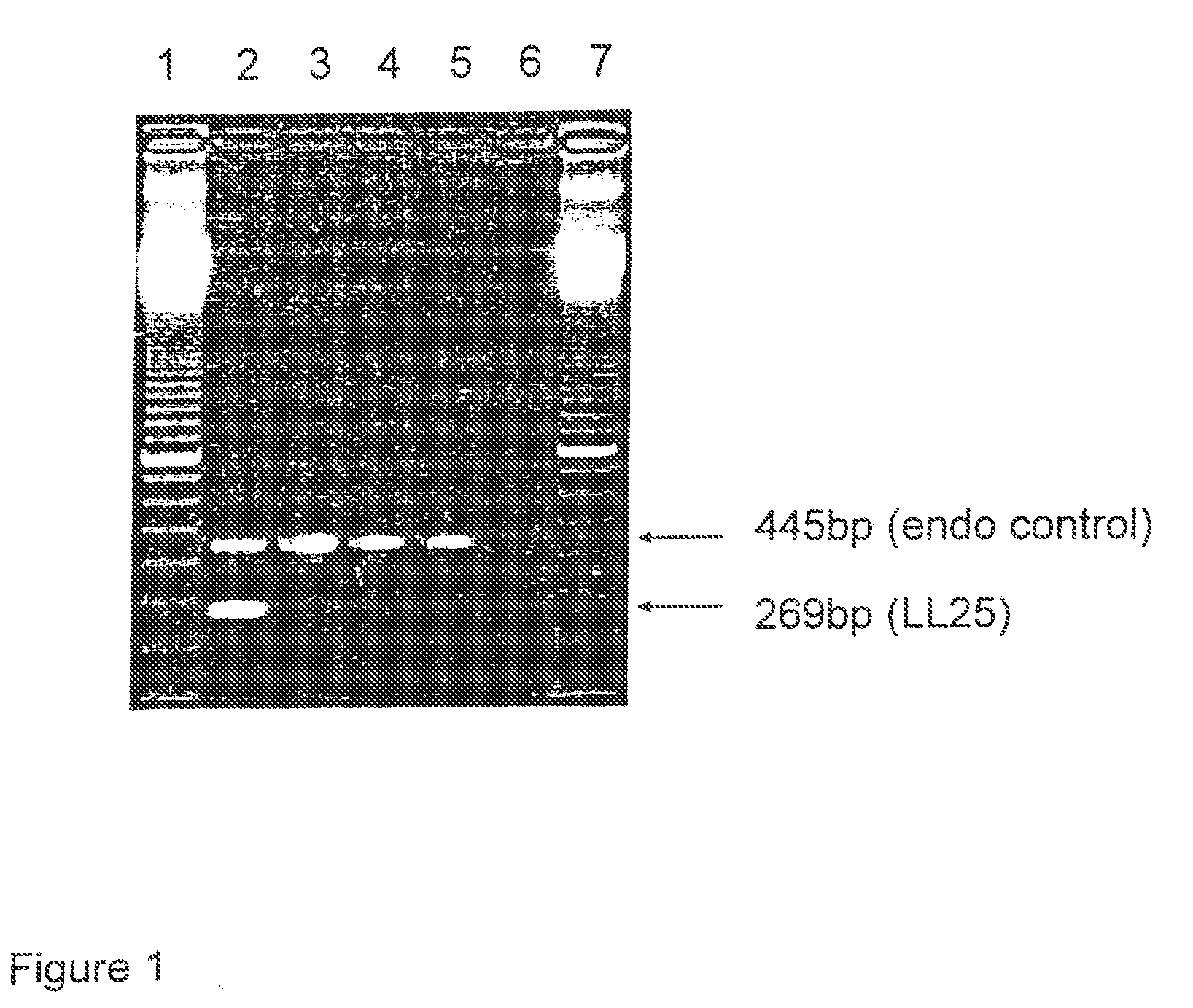Herbicide tolerant cotton plants and methods for producing and identifying same
a technology of herbicide-tolerant cotton plants and cotton plants, which is applied in the field of transgenic cotton plants, can solve the problems of time-consuming, potentially damaging to the crop, and not always possible, and achieve the effect of superior agronomic phenotyp
- Summary
- Abstract
- Description
- Claims
- Application Information
AI Technical Summary
Benefits of technology
Problems solved by technology
Method used
Image
Examples
example 1
Transformation of Cotton with a Herbicide Tolerance Gene
1.1. Construction of the Chimeric DNA Comprising the Bar Gene Under the Control of a Constitutive Promoter
[0073]A plasmid pGSV71 was constructed following standard procedures. The sequence of the genetic elements of plasmid pGSV71 is given in fable 1 (SEQ ID NO: 6):
TABLE 1Nucleotide positions of the genetic elements in pGSV71NtpositionsAbbreviationDescription and references198-222—Right border Repeat from the TL-DNA frompTiB6S3 (Gielen et al., 1984, EMBO J. 3:835-848)223-249—Polylinker 250-1634P35S3Promoter of the 35S RNA of CauliflowerMosaic Virus (Odell et al., (1985),Nature 313: 810-812)1835-2186barCoding sequence encoding phosphinothricine-acetyl-transferase from Streptomyceshygroscopicus (Thompson et al., (1987)EMBO J. 6: 2519-2523). The N-terminal twocodons of the wild-type bar coding regionhave been substituted for codons ATG andGAC respectively.2187-2205—Polylinker2206-24653′nosA 260 bp TaqI fragment from the 3′un-trans...
example 2
Development of Events
2.1. Development of Lines Carrying the Event Trait
[0077]T0 shoots were transferred to greenhouse soil and plants were screened for glufosinate tolerance and for the presence of the PAT enzyme with a PAT ELISA (Steffens Biotechnische Analysen GmbH, Ebringen, Germany).
[0078]T1 to T3 plants were grown in the greenhouse and tested for Liberty™ tolerance at a 2× rate (by spraying 56 oz / ha). Positive plants were tested for expression of the bar gene using the Pat assay as described by Deblock et al. 1987 (EMBO J. 6:2513-2518).
[0079]Presence of the foreign DNA and copy number was checked by Southern blot analysis. Total genomic DNA was isolated from 1 g of leaf tissue according to the CETAB method of Doyle et al. (1987. Phytochem. Bull. 19:11) and digested with EcoRI restriction enzyme.
[0080]Probes such as the following were used for Southern analysis:
“bar” probe: 474 bp KpnI-BglI digest of plasmid pDE110 (WO 92 / 09898)
“35S” probe: 892 bp NcoI-MunI digest of plasmid pRV...
example 3
Characterization of Elite Event EE-GH1
3.1 In-Depth Molecular and Genetic Analysis of the Locus
[0094]Once the EE-GH1 event was identified as the event in which expression of the transgene as well as overall agronomic performance were optimal, the locus of the transgene was analyzed in detail on a molecular level. This included sequencing of the flanking regions of the transgene.
[0095]The sequence of the regions flanking the inserted transgene in the EE-GH1 event was determined using the TAIL-PCR protocol as described by Liu et al. (1995, Plant J. 8(3): 457-483).
a) Determination of the 5′ Flanking Region
[0096]The primers used were:
PositionSequence (5′ → 3′)in PGSV71DegenerateMDB327NTg.Agg.WTC.NWg.TSA.T—primer(SEQ ID NO: 8)PrimaryMLD015Tgg.TTC.CTA.gCg.TgA.gCC.AgT.g606→585TAIL(SEQ ID NO: 9)Second.MLD016AgC.TgC.TgC.TCT.TgC.CTC.TgT467→447TAIL(SEQ ID NO: 10)TertiaryGHI05ggA.CCg.TTA.TAC.ACA.ACg.Tag358→338TAIL(SEQ ID NO: 3)Whereby N = A, C, T or g; S = C or g; W = A or T
[0097]The fragment am...
PUM
| Property | Measurement | Unit |
|---|---|---|
| temperature | aaaaa | aaaaa |
| temperature | aaaaa | aaaaa |
| volume | aaaaa | aaaaa |
Abstract
Description
Claims
Application Information
 Login to View More
Login to View More - R&D
- Intellectual Property
- Life Sciences
- Materials
- Tech Scout
- Unparalleled Data Quality
- Higher Quality Content
- 60% Fewer Hallucinations
Browse by: Latest US Patents, China's latest patents, Technical Efficacy Thesaurus, Application Domain, Technology Topic, Popular Technical Reports.
© 2025 PatSnap. All rights reserved.Legal|Privacy policy|Modern Slavery Act Transparency Statement|Sitemap|About US| Contact US: help@patsnap.com

